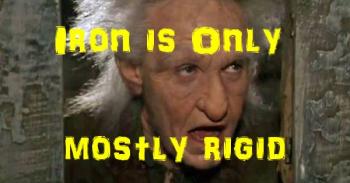Ask Professor Puzzler
Do you have a question you would like to ask Professor Puzzler? Click here to ask your question!
Seventh grader omarion, from Georgia, asks, "Why can the “M” and the “D” switch places without changing the order of operations?"
Hi omarion! You've hit on one of the things that is most confusing about Order of Operations. It shouldn't be confusing, but I think sometimes teachers either don't teach Order of Operations correctly, or they teach it correctly but unclearly or incompletely.
You've probably been taught PEMDAS, which stands for: parentheses, exponents, multiplication, division, addition, and subtraction. And you may have been told you can remember PEMDAS by remembering the silly phrase, "Please Exuse My Dear Aunt Sally," in which the first letter of each word corresponds to the first letter of each word in the PEMDAS list.
If that's what you were taught, it's not wrong...exactly...but it's also not complete.
So let me tell it to you a different way.
- Grouping symbols (like parentheses) are most important.
- Exponents are the next most important operation.
- Multiplication and Division are equally important, and they are next after exponents.
- Addition and Subtraction are equally important, and they are after multiplication and division.
- If you have operations that are equally important, you do them in the order that you read the expression (from left to right!)
Multiplication and Division are equally important, so you need to do them from left to right. Similarly, you do addition and subtraction from left to right. So let's try an example problem.
3 · (3 + 5) - 2 ÷ (33 - 52) + 3 · 2
To help you understand how we do this, we're going to simplify it one step at a time. Ready?
Order of operations says that we do parentheses first. But there are two sets of parentheses, right? Which one has higher priority? That's where our last rule comes into play. The one on the left comes first. So first we evaluate the first set of parentheses:
3 · 8 - 2 ÷ (33 - 52) + 3 · 2
Then we evaulate the only other set of parentheses. But wait! the second set of parentheses has multiple operations! Two exponents, and one division! So we tackle this in the following order: first exponent, second exponent, then subtraction. Here it is:
3 · 8 - 2 ÷ (27 - 52) + 3 · 2
3 · 8 - 2 ÷ (27 - 25) + 3 · 2
3 · 8 - 2 ÷ 2 + 3 · 2
So what's next? Multiplication and division. Which is more important? Neither! They're equally important. So we do them from left to right. So follow each step, and see which operation I evaluate in each step.
24 - 2 ÷ 2 + 3 · 2
24 - 1 + 3 · 2
24 - 1 + 6
Now we only have addition and subtraction. Which is more important? Neither! So we go from left to right, which means doing the subtraction, and then the addition:
23 + 6
29
So, in answer to your question, why can we switch the "M" and the "D" in PEMDAS? It's because neither M nor D is more important than the other. Similarly, neither A nor S is more important than the other. So actually, if I wanted, instead of talking about PEMDAS, I suppose I could talk about...
PEDMSA!
Which, of course, stands for...
Professional Educators Delight Many Students of Algebra!
Good morning Puzzling Friends! I have a puzzle for you all.
rinku sends us the following question: "How can we get one using the numbers 1 to 10 in the same order using the four operations?"
This is all we have for details on this puzzle. It is not clear, from the wording, whether parentheses are allowed.
For example, are you allowed to do things like this: 1(2 + 3 - 4) + 5... etc. If you can use parentheses, that simplifies the problem, I'm sure!
I'm curious to see how many different solutions we can come up with. Try doing it without parentheses, and if you can't solve it, try it with parentheses. Use the "Ask Professor Puzzler" link at the bottom of the page to submit your answer.
I'll update this blog post with the first/best submissions, so make sure you check back next week to see what solutions have been shared!
The only solutions which were posted were variations on a single theme.
It occurred to me, as I looked at this, that each pair of successive integers had a difference of one (or negative one, depending on which way you do the subtraction). Thus, if we alternate adding and subtracting differences, we'll get the desired solution:
First we add 2 to -1.
Then we subtract 4 from 3.
Then we add 6 to -5.
Then we subtract 8 from 7.
Finally, we add 10 to -9.
-1 + 2 +3 - 4 - 5 + 6 + 7 - 8 - 9 + 10 = 1
The other solutions received were simply variations on the add and subtract differences concept, such as:
1 - 2 + 3 - 4 - 5 + 6 - 7 + 8 - 9 + 10 = 1.
Many other variations are possible.
Can you find a solution that includes operations besides addition and subtraction? Use the "Ask Professor Puzzler" link to give us your solution!
Mohamed from Maldives asks the following question: "Mr. Smith and his son are driving in a car. They get into an accident. Mr. Smith dies and his son rushed into the hospital and the surgeon said I cant operate on him because he is my SON. How is that?"
Hi Mohamed, this is an old, old riddle which is slowly disappearing from usage. Because of changes in society, people are becoming more and more likely to recognize the answer quickly. I'll explain what I mean in a minute, but first, the answer to your question:
The surgeon was his mother.

I first heard this riddle when I was a child in the early seventies. At the time, although I didn't know it, the percentage of doctors in the US who were female was less than 10%, and the percentage who were surgeons was even smaller.
In addition, every book I read that talked about doctors, always used "he" as the pronoun, and if there was a picture it was always something like the picture shown here.
Lab coat, stethoscope, maybe a black bag, but most importantly, guaranteed, it was a picture of a male doctor. True, there were female doctors, and female surgeons, when I was a child, but nobody ever pictured doctors as being female. Thus, the riddle was a bit tricky. Your brain automatically pictures a surgeon as male, because that's how you've been conditioned over time to picture surgeons!
In the US, where I live, things have changed a lot since the days when I was a kid. Now the percentage of surgeons who are female is significantly higher. Of course, it depends on the field of surgery; OB/GYN surgeons are almost 50% female. Other areas have a much smaller percentage of women in them. Pediatric surgery is just a little under 20% female.
So we don't tend to automatically assume that a surgeon is male, and the riddle seems less perplexing.
The percentage of women in surgical fields varies depending on where you live. In your part of the world, although there is a very high rate of females who attend medical school (I think I read that in one of the neighboring countries to yours, more than 50% of students enrolled in medical schools in 2015 were female), a very small percentages of them go into surgery. I'm not sure why that is; it would be an interesting sociological question to explore! Regardless, since the percentage of female surgeons is much smaller, the riddle didn't seem quite so obvious to you.
Someday, probably, this riddle will stop being told altogether, and children will learn the riddle by reading sites like this one, and they'll say, "What? People didn't know that women can be doctors?"
They say that if my hot chocolate is too hot to drink, I should stir it, because that helps to cool it down. But doesn't stirring increase the temperature by adding friction between the hot chocolate and the spoon?

Interesting question! You are correct that stirring will cause friction. Not just between the spoon and the hot chocolate, but also between the hot chocolate and the mug it's swirling around in. And, unless you are careful to avoid touching the spoon against the mug, there's also friction between the mug and the spoon.
And yes, if that's all that was happening, the temperature of your hot chocolate would rise (although probably not enough that you would notice it!).
But there's something else happening here. Heat is transferring from your hot chocolate to the cooler air above it.
And here's why stirring could make a difference: heat transfers more rapidly when there's a larger temperature difference. You know this, because your house loses heat more quickly in the winter than it does in the spring. If the temperature outside is 0ºC, you'll lose heat more rapidly than if the temperature was 15ºC.
Similarly, your hot chocolate is losing heat to the air above it. The air above your mug is warming up, while the hot chocolate is gradually cooling down.
The problem is, your hot chocolate is not losing heat uniformly. The surface is cooling down rapidly, while deep in the mug it's still very hot. You can test this for yourself. Scoop a spoonful of hot chocolate from the surface and drink it, then take a spoonful from deeper in the mug. You'll find that the deeper spoonful is hotter. So the surface is cooling rapidly, while underneath it is not. As the surface of your hot chocolate cools down, and the air warms up, the temperature difference is decreasing. And if the temperature difference is decreasing, that means that the rate of heat loss is decreasing.
Meanwhile, the deeper-down hot chocolate is gradually losing heat to the cooler upper layer, but that's a slow process.
How to speed that process up? Stir your hot chocolate occasionally! That'll bring some of the hotter beverage to the surface. Now you'll have a higher temperature difference, and the rate of heat loss will increase.
Incidentally, while we're on the subject of heat loss, you can also help your hot chocolate cool down faster by moving it around on the table periodically. After all, every time you move it away from the air it has heated up, to cooler air, you've increased the temperature difference again. Will that significantly increase the rate of cooling? Probably not, but it'll make you feel like you're doing something useful while you wait, which is probably the real reason people stir in the first place!
Jakob saw a multiple choice question on a website, and was surprised by the answer. He was curious to know what Professor Puzzler thought.
Here's the question: You have an iron rod which is 1 light year in length. You push one end of the rod. How long does it take before the other end moves? The options are:
A: Immediately
B: 1 week
C: 1 year
D: at least 1,000 years.
The "instinctive" answer is to say A - the moment you move one end is the moment the other end moves. And, as you might guess, from the fact that we're being asked to explain it, A is not correct.
To help understand what's happening here, I'd like you to imagine that the rod is not made of iron. I want you to imagine instead that it's made of marshmallow. Yes, that's right - one single marshmallow that's 1 light year tall.
Now imagine what happens when you push one end. Can you visualize it? As you push, the marshmallow rod compresses (squishes) right by where you pushed it. Of course, it won't stay compressed, and since it can't "rebound" to its original position (your hand is in the way, and you're still pushing), the compressed section will decompress by pushing the compression down the length of the rod. In other words, you'll create a wave of compressed marshmallow that will travel the length of the rod.
"Ah, yes," you might say, "but that's marshmallow. A marshmallow is squishy. An iron rod isn't squishy. It's rigid."

Well, yes and no. It's kind of like "The Princess Bride," where Miracle Max concludes that "mostly dead is partly alive." Iron is "mostly rigid," and mostly rigid is partly squishy. It will compress. The motion of the rod is actually a wave of motion, just like with the marshmallow. The other end of your rod will move after you've pushed your end.
How much after? Well, that's a good question. And I don't know the answer. But I do know this: the speed of that wave is significantly slower than the speed of light. And how long does it take light to travel the length of the rod? Since the definition of a "light year" is "the distance light will travel in a year," we can conclude that light takes a year to travel the length of the rod. And therefore, the amount of time it takes for the other end of the rod to move is more than a year. If you look at your possible answers, D is the only one that is more than a year. Therefore, if any of the answers are correct, D must be the one!
It seems counter-intuitive; when you are dealing with much smaller "mostly rigid" objects, it appears to you as though the other end moves simultaneously with the end you pushed. The key is the word "appears." There is actually a tiny, tiny delay, which is so short you couldn't possibly measure it. But when you are dealing with such an astronomical distance (the length of your rod is 63 thousand times the distance from the earth to the sun!), that tiny, tiny delay is suddenly not tiny any more!
Incidentally, I hope you're planning to push very very hard, if you intend to move that rod of yours any significant distance. If we assume that the radius of the rod is 1 centimeter, its mass is about 23 quadrillion kilograms, which would make for a decent sized asteroid, if it wasn't so oddly shaped!


